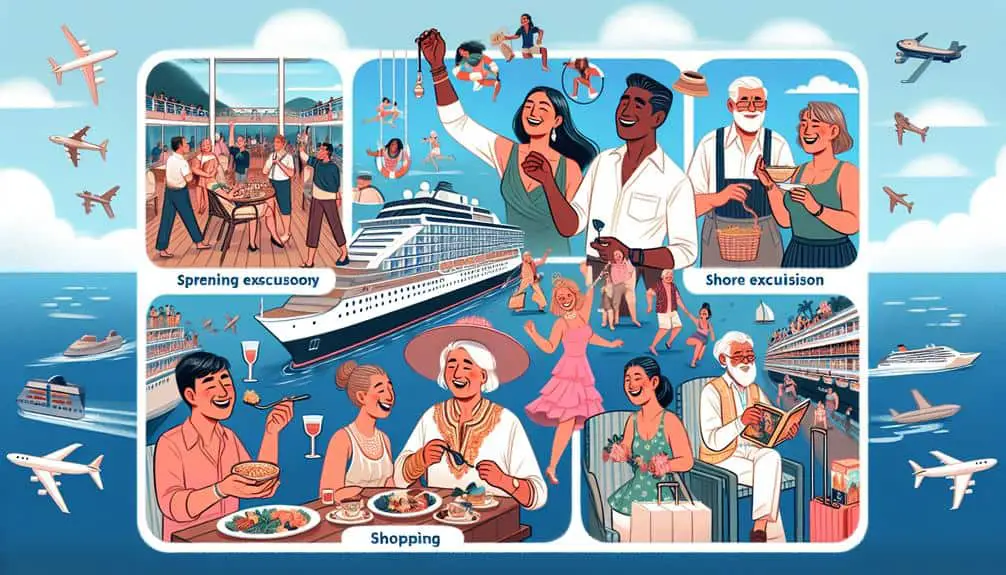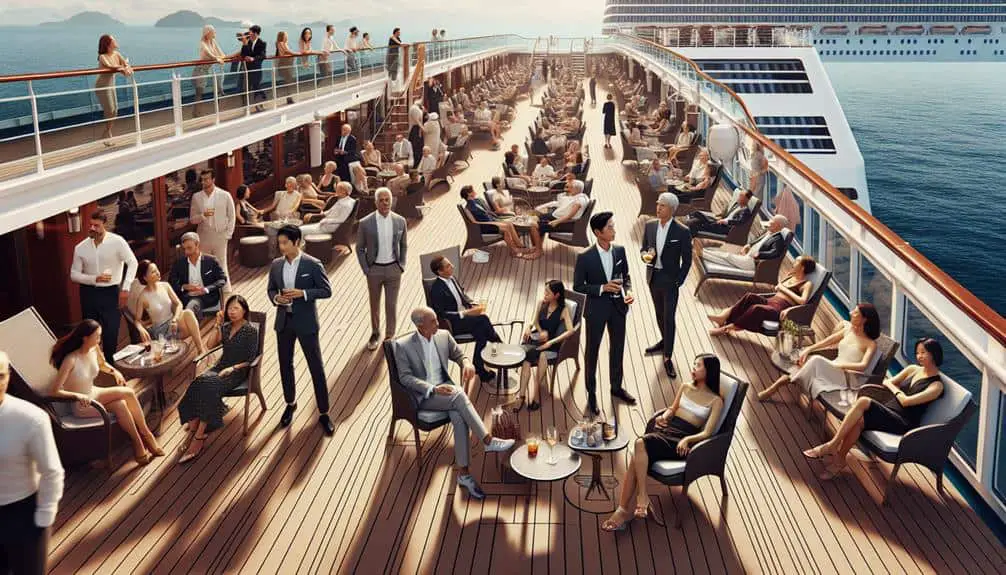Generational differences are key in shaping passenger spending on cruises; baby boomers focus on activities and lavish dining, while millennials splurge on excursions and unique entertainment. Travel companions also sway spending, as group dynamics encourage splurging, while solo travelers opt for budget-friendly choices. Cruise itineraries impact spending, with destination choices affecting excursion and dining expenses. Onboard amenities like luxury dining and exclusive activities drive up spending. Analyzing passenger feedback reveals spending trends, guiding tailored services for enhanced experiences. Understanding these factors can optimize your cruise budgeting strategies.
Key Points
- Passenger age and generational differences impact onboard spending patterns.
- Travel companions influence onboard experiences and expenditure decisions.
- Cruise itinerary and destination preferences affect spending on excursions and dining.
- Onboard amenities like luxury options and entertainment impact passenger spending.
- Analyzing passenger feedback helps tailor offerings and adapt services to enhance guest experience.
Passenger Age and Spending Patterns
When analyzing passenger age in relation to spending patterns on cruise vacations, significant correlations emerge that shed light on consumer behavior. Generational differences play an important role in determining spending habits onboard a cruise ship. Baby boomers, for example, tend to allocate a larger portion of their budget to onboard activities and luxurious dining experiences, whereas millennials often prioritize spending on excursions and entertainment options that offer unique experiences. Understanding these generational disparities is essential for cruise companies to tailor their offerings effectively.
Moreover, lifestyle preferences heavily influence how different age groups allocate their budget while on a cruise vacation. Older passengers may prefer more relaxed activities like spa treatments and wine tastings, while younger passengers might lean towards adrenaline-filled adventures such as zip-lining or scuba diving. Recognizing these lifestyle variations allows cruise lines to curate a diverse range of onboard amenities and excursions to cater to the varying preferences of their passengers. By acknowledging these nuances in spending patterns based on age and lifestyle, cruise companies can enhance the overall passenger experience and maximize revenue opportunities.
Influence of Travel Companions
Passenger spending on cruise vacations is greatly influenced by the companions individuals choose to travel with, shaping their onboard experiences and expenditure patterns. Group dynamics play a significant role in determining spending habits during the cruise. Traveling with a group can lead to shared expenses on activities or dining, encouraging passengers to indulge more than they'd if traveling alone. Additionally, group dynamics can create a social pressure to participate in certain onboard experiences, further influencing spending behaviors.
On the other hand, solo travelers may have different priorities due to budget constraints. They might opt for more economical choices regarding dining and activities to stay within their financial limits. Solo travelers often focus on experiences that align with their personal preferences rather than following group trends, impacting their spending habits on the cruise. Understanding these dynamics can help cruise companies tailor their offerings to cater to both group travelers looking for shared experiences and solo travelers seeking individualized options.
Impact of Cruise Itinerary
How does the cruise itinerary impact passenger spending habits on board?
The cruise itinerary plays an essential role in influencing how much passengers spend during their voyage. Here's how it can impact your spending:
- Destination Preferences:
The ports of call and destinations included in the cruise itinerary can greatly influence passenger spending. Travelers often allocate more budget for places they're excited to visit, leading to increased spending on shore excursions, shopping, and dining experiences at these preferred destinations.
- Excursion Options:
The variety and quality of shore excursions offered at each stop can also impact passenger spending habits. Travelers who are presented with a wide range of appealing excursion options are more likely to spend extra on these activities to enhance their overall cruise experience.
- Budgeting Strategies:
The structure of the cruise itinerary, including the number of sea days versus port days, can influence how passengers budget their onboard expenses. Travelers may adjust their spending habits based on whether they plan to indulge in onboard amenities during sea days or save up for experiences at the upcoming ports of call.
Onboard Amenities and Spending
The choice and availability of onboard amenities have a substantial impact on passenger spending patterns during a cruise voyage. Luxury options onboard can greatly influence how much passengers spend during their trip. Passengers with higher budgets may opt for premium dining experiences, spa treatments, or exclusive onboard activities, contributing to increased spending. On the other hand, those with budget constraints might stick to included amenities and spend less on additional luxuries.
Entertainment choices also play an important role in passenger spending. Passengers interested in specialty shows, onboard events, or unique entertainment options may allocate more of their budget to these experiences. Additionally, onboard shopping for souvenirs, designer goods, or exclusive merchandise can lead to increased spending.
Balancing onboard amenities with budget constraints is essential for passengers looking to control their expenses. Understanding the allure of luxury options and managing entertainment choices can help passengers make informed decisions about where to allocate their funds, especially considering potential excursion expenses.
Passenger Feedback and Spending Trends
Analyzing feedback from passengers reveals distinct spending trends that offer valuable insights into the financial behaviors of cruise vacationers. Through feedback analysis, cruise lines can better understand customer preferences and purchase behavior, shaping their offerings to align with these trends. Here are key points to take into account:
- Feedback Analysis: Utilizing advanced analytics tools to dissect passenger feedback can unearth patterns in spending habits, highlighting areas where guests are willing to invest more during their cruise experience.
- Spending Trends: By tracking spending trends over time, cruise companies can adapt their onboard services and amenities to capitalize on popular spending categories, maximizing revenue potential.
- Customer Preferences: Understanding customer preferences through feedback analysis allows cruise lines to tailor their offerings, enhancing the overall guest experience and potentially increasing onboard spending.
Frequently Asked Questions
How Do Cultural Differences Influence Passenger Spending on Cruise Vacations?
When it comes to cultural influences on your cruise spending patterns, various factors like traditions, values, and norms play a role. These elements shape your preferences, activities, and purchases onboard, impacting your overall expenditure.
What Role Does the Cruise Line's Reputation Play in Determining Passenger Spending Habits?
When considering what role the cruise line's reputation plays in determining your spending habits, brand loyalty is key. Positive customer reviews can influence your decisions. Marketing strategies and social media trends also shape perceptions and impact your choices.
Do Passengers Tend to Spend More on Excursions or Onboard Activities During Their Cruise Vacation?
When choosing between excursions and onboard activities, passengers tend to spend more on excursions, driven by the desire for unique experiences ashore. Spending trends reveal a preference for immersive cultural interactions over onboard amenities.
How Does the Length of the Cruise Impact Passenger Spending Patterns?
When you set sail on a longer cruise, your spending patterns tend to shift. Passengers often allocate more funds towards onboard dining and entertainment on extended voyages, while shore excursions and souvenirs remain popular choices regardless of cruise duration.
Are There Any Emerging Trends in the Cruise Industry That Are Affecting Passenger Spending Behavior?
Emerging trends in the cruise industry, like sustainability initiatives and digitalization, are reshaping passenger spending habits. Personalization and social media engagement play a significant role in influencing how passengers allocate their budgets on cruise vacations.




